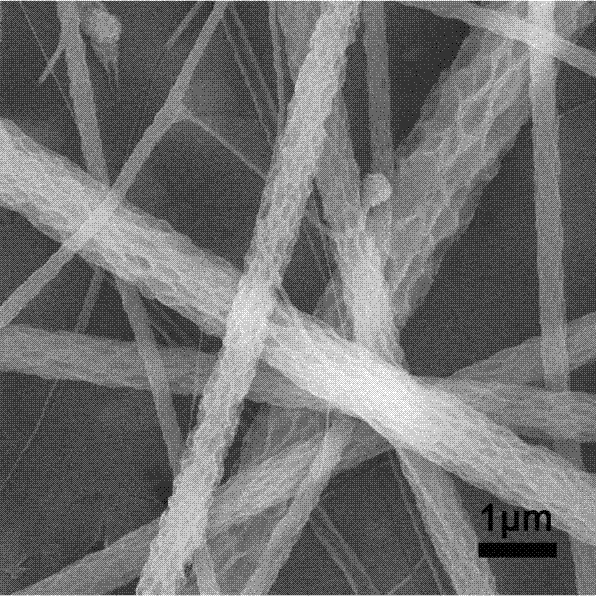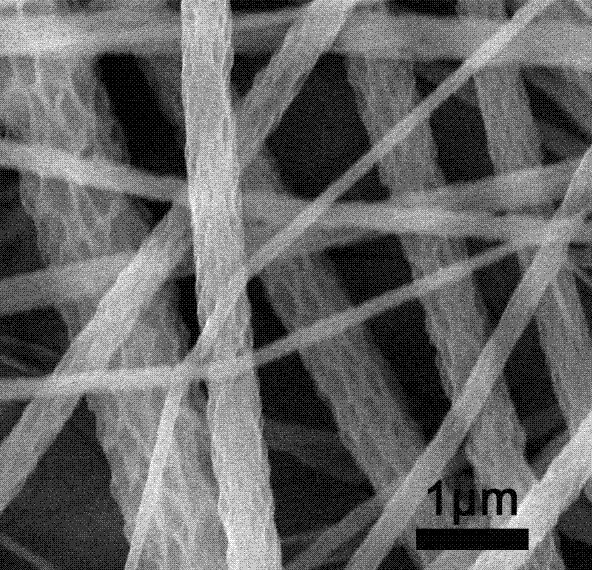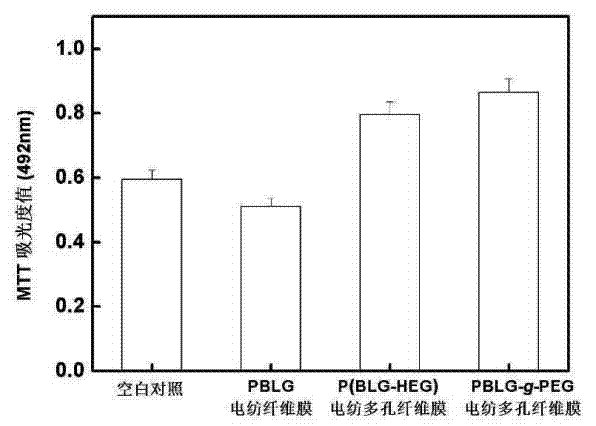Method for preparing polypeptide copolymer porous nanofiber by using electrostatic spinning
A technology of electrospinning and nanofibers, which is applied in the direction of spinning solution preparation, single-component copolyamide artificial filament, fiber treatment, etc., can solve problems such as constraints and poor cell adhesion performance, and achieve good biophase Capacitance, effect of promoting cell adhesion and growth
- Summary
- Abstract
- Description
- Claims
- Application Information
AI Technical Summary
Problems solved by technology
Method used
Image
Examples
Embodiment 1
[0031] A method for preparing polypeptide copolymer porous nanofibers by electrospinning, the preparation steps are:
[0032] (1) Hydrophilic modification of homopolypeptide
[0033] For hydrophobic peptides—poly( -Benzyl L-glutamate) (PBLG) for hydrophilic modification:
[0034] In a 250mL reaction bottle, add 2g of poly( -benzyl L-glutamate) (PBLG), 100mL refined dioxane and 3mL ethanolamine (ETA), reacted with electromagnetic stirring at 60°C for 11 hours, then precipitated, filtered, and dried in vacuo to obtain white poly( -Benzyl L-glutamate-hydroxyethylglutamine) [P(BLG-HEG)] solid 1.8 g; degree of substitution with ethanolamine (ETA) 5%.
[0035] (2) Preparation of spinning dope
[0036] 0.16g of poly( -Benzyl L-glutamate-hydroxyethylglutamine)[P(BLG-HEG)] random copolymer was dissolved in 2 mL of volatile organic solvent tetrahydrofuran / dichloromethane with volume ratio of 80:20 (v:v) In a compound solvent of methane (THF / DCM), a solution with a concentratio...
Embodiment 2
[0045] A method for preparing polypeptide copolymer porous nanofibers by electrospinning, the preparation steps are:
[0046] (1) Hydrophilic modification of homopolypeptide
[0047] Basic content is the same as embodiment 1, and difference is:
[0048] Poly( The molecular weight of -benzyl L-glutamate) (PBLG) is 230000g / mol, ethanolamine (ETA) is 6mL, the reaction time of electromagnetic stirring under 60 ℃ is 20 hours, and the substitution degree of ethanolamine (ETA) is 11%.
[0049] (2) Preparation of spinning dope
[0050] 0.14g of poly( -Benzyl L-glutamate-hydroxyethylglutamine) [P(BLG-HEG)] random copolymer is dissolved in the volatile organic solvent trichloromethane / tri In the compound solvent of fluoroacetic acid (TCM / TFA), stir evenly, and prepare the electrospinning stock solution with a concentration of 5% (w / v).
[0051] (3) Perform high-voltage electrospinning
[0052] The electrospinning stock solution in step (2) was subjected to high-voltage electrosp...
Embodiment 3
[0058] A method for preparing polypeptide copolymer porous nanofibers by electrospinning, the preparation steps are:
[0059] (1) Hydrophilic modification of the homopolypeptide (same as Example 2).
[0060] (2) Preparation of spinning dope
[0061] 0.26g of poly( -Benzyl L-glutamate-hydroxyethylglutamine) [P(BLG-HEG)] random copolymer is dissolved in the volatile organic solvent trichloromethane / tri In a compound solvent of fluoroacetic acid (TCM / TFA), stir evenly to prepare an electrospinning stock solution with a concentration of 13% (w / v).
[0062] (3) Perform high-voltage electrospinning
[0063] The electrospinning stock solution in step (2) was subjected to high-voltage electrospinning under the conditions of a spinning voltage of 13kV, a receiving distance from the spinneret to the aluminum foil of 13cm, and an extrusion flow rate of 1mL / h.
[0064] (4) vacuum drying
[0065] (Same as Example 1), the target product—porous nanofibers with high specific surface are...
PUM
| Property | Measurement | Unit |
|---|---|---|
| degree of substitution | aaaaa | aaaaa |
| degree of substitution | aaaaa | aaaaa |
Abstract
Description
Claims
Application Information
 Login to View More
Login to View More - R&D
- Intellectual Property
- Life Sciences
- Materials
- Tech Scout
- Unparalleled Data Quality
- Higher Quality Content
- 60% Fewer Hallucinations
Browse by: Latest US Patents, China's latest patents, Technical Efficacy Thesaurus, Application Domain, Technology Topic, Popular Technical Reports.
© 2025 PatSnap. All rights reserved.Legal|Privacy policy|Modern Slavery Act Transparency Statement|Sitemap|About US| Contact US: help@patsnap.com



